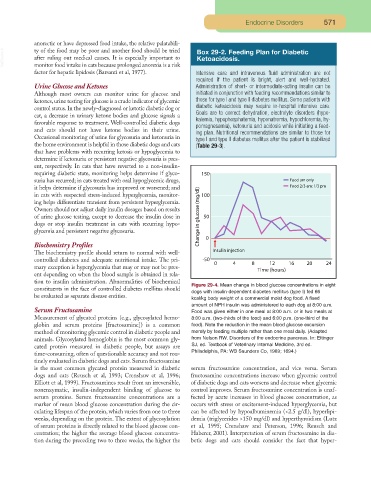Page 552 - Small Animal Clinical Nutrition 5th Edition
P. 552
Endocrine Disorders 571
anorectic or have depressed food intake, the relative palatabili-
VetBooks.ir ty of the food may be poor and another food should be tried Box 29-2. Feeding Plan for Diabetic
after ruling out medical causes. It is especially important to
Ketoacidosis.
monitor food intake in cats because prolonged anorexia is a risk
factor for hepatic lipidosis (Barsanti et al, 1977). Intensive care and intravenous fluid administration are not
required if the patient is bright, alert and well-hydrated.
Urine Glucose and Ketones Administration of short- or intermediate-acting insulin can be
Although most owners can monitor urine for glucose and initiated in conjunction with feeding recommendations similar to
ketones,urine testing for glucose is a crude indicator of glycemic those for type I and type II diabetes mellitus. Some patients with
diabetic ketoacidosis may require in-hospital intensive care.
control status. In the newly-diagnosed or ketotic diabetic dog or
Goals are to correct dehydration, electrolyte disorders (hypo-
cat, a decrease in urinary ketone bodies and glucose signals a
kalemia, hypophosphatemia, hyponatremia, hypochloremia, hy-
favorable response to treatment. Well-controlled diabetic dogs
pomagnesemia), ketonuria and acidosis while initiating a feed-
and cats should not have ketone bodies in their urine.
ing plan. Nutritional recommendations are similar to those for
Occasional monitoring of urine for glycosuria and ketonuria in type I and type II diabetes mellitus after the patient is stabilized
the home environment is helpful in those diabetic dogs and cats (Table 29-3).
that have problems with recurring ketosis or hypoglycemia to
determine if ketonuria or persistent negative glycosuria is pres-
ent, respectively. In cats that have reverted to a non-insulin-
requiring diabetic state, monitoring helps determine if glyco- 150
suria has recurred; in cats treated with oral hypoglycemic drugs, Food am only
it helps determine if glycosuria has improved or worsened; and Food 2/3 am: 1/3 pm
in cats with suspected stress-induced hyperglycemia, monitor- 100
ing helps differentiate transient from persistent hyperglycemia.
Owners should not adjust daily insulin dosages based on results
of urine glucose testing, except to decrease the insulin dose in Change in glucose (mg/dl) 50
dogs or stop insulin treatment in cats with recurring hypo-
glycemia and persistent negative glycosuria. 0
Biochemistry Profiles
The biochemistry profile should return to normal with well- Insulin injection
controlled diabetes and adequate nutritional intake. The pri- -50
0 4 8 12 16 20 24
mary exception is hyperglycemia that may or may not be pres-
Time (hours)
ent depending on when the blood sample is obtained in rela-
tion to insulin administration. Abnormalities of biochemical
Figure 29-4. Mean change in blood glucose concentrations in eight
constituents in the face of controlled diabetes mellitus should
dogs with insulin-dependent diabetes mellitus (type I) fed 66
be evaluated as separate disease entities. kcal/kg body weight of a commercial moist dog food. A fixed
amount of NPH insulin was administered to each dog at 8:00 a.m.
Serum Fructosamine Food was given either in one meal at 8:00 a.m. or in two meals at
Measurement of glycated proteins (e.g., glycosylated hemo- 8:00 a.m. (two-thirds of the food) and 6:00 p.m. (one-third of the
globin and serum proteins [fructosamine]) is a common food). Note the reduction in the mean blood glucose excursion
method of monitoring glycemic control in diabetic people and merely by feeding multiple rather than one meal daily. (Adapted
animals. Glycosylated hemoglobin is the most common gly- from Nelson RW. Disorders of the endocrine pancreas. In: Ettinger
cated protein measured in diabetic people, but assays are SJ, ed. Textbook of Veterinary Internal Medicine, 3rd ed.
Philadelphia, PA: WB Saunders Co, 1989; 1694.)
time-consuming, often of questionable accuracy and not rou-
tinely evaluated in diabetic dogs and cats. Serum fructosamine
is the most common glycated protein measured in diabetic serum fructosamine concentration, and vice versa. Serum
dogs and cats (Reusch et al, 1993; Crenshaw et al, 1996; fructosamine concentrations increase when glycemic control
Elliott et al, 1999). Fructosamines result from an irreversible, of diabetic dogs and cats worsens and decrease when glycemic
nonenzymatic, insulin-independent binding of glucose to control improves. Serum fructosamine concentration is unaf-
serum proteins. Serum fructosamine concentrations are a fected by acute increases in blood glucose concentration, as
marker of mean blood glucose concentration during the cir- occurs with stress or excitement-induced hyperglycemia, but
culating lifespan of the protein, which varies from one to three can be affected by hypoalbuminemia (<2.5 g/dl), hyperlipi-
weeks, depending on the protein. The extent of glycosylation demia (triglycerides >150 mg/dl) and hyperthyroidism (Lutz
of serum proteins is directly related to the blood glucose con- et al, 1995; Crenshaw and Peterson, 1996; Reusch and
centration; the higher the average blood glucose concentra- Haberer, 2001). Interpretation of serum fructosamine in dia-
tion during the preceding two to three weeks, the higher the betic dogs and cats should consider the fact that hyper-

